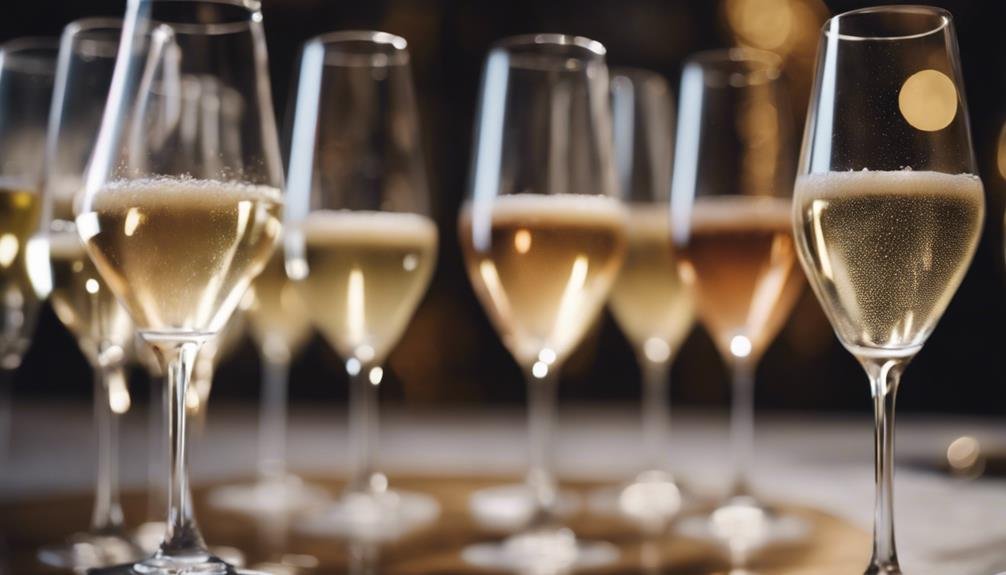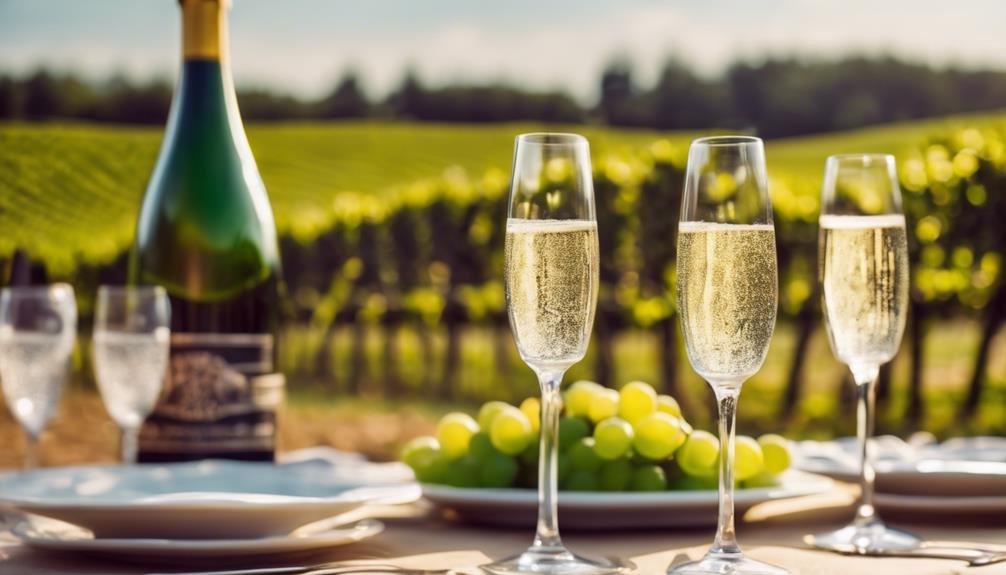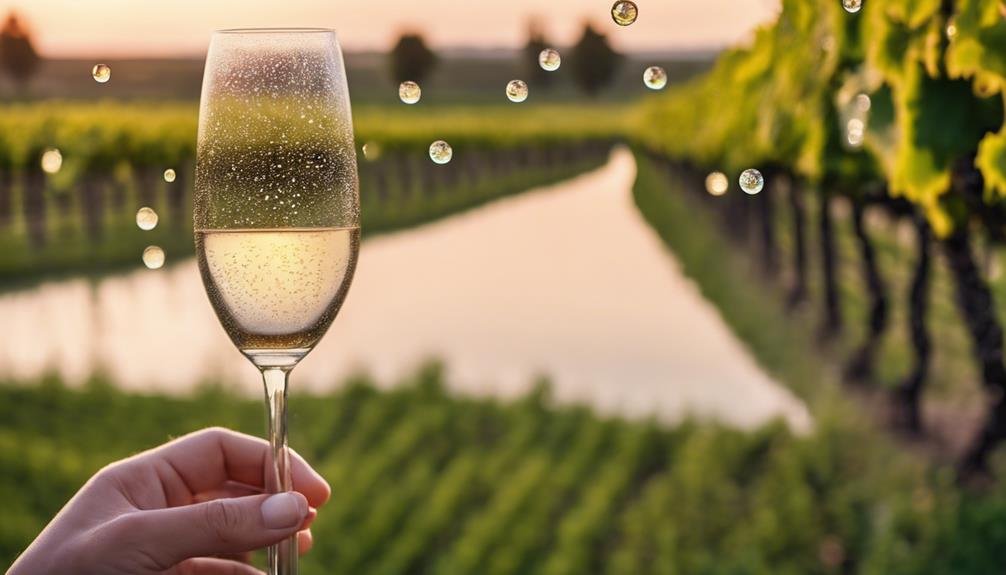Cava wine originates in Catalonia, Spain, initially named Champaña de Espańa. Produced from indigenous grapes like Macabeo, Parellada, and Xarel-lo, it adheres to strict regulations, offering aging categories like Reserva and Gran Reserva. Macabeo and Parellada pair well with seafood, while Xarel-lo complements charcuterie. The Penedès region in Spain is the primary grape source, contributing to diverse Cava flavors. Styles range from the base Brut to the prestigious Gran Reserva requiring a minimum of 30 months aging. The meticulous process involves bottle fermentation and lees aging, enriching Cava with distinct brioche and nutty nuances. Discover the enchanting world of Cava wine.
History of Cava Production
Originating from the Catalonia region of Spain, the history of Cava production dates back to the late 19th century. Initially known as Champaña de Espańa, Cava evolved from traditional methods of winemaking influenced by French Champagne production.
The use of indigenous grape varieties such as Macabeo, Parellada, and Xarel-lo distinguishes Cava from its French counterpart. The strict regulations governing Cava production guarantee adherence to these traditional methods, emphasizing quality and authenticity.
The evolution of Cava has seen an increase in aging requirements, with Reserva and Gran Reserva designations demanding extended periods on lees. This dedication to traditional techniques has solidified Cava's reputation as a premium sparkling wine, offering a unique expression of Spanish winemaking heritage.
Grape Varieties in Cava
Among the notable grape varieties utilized in the production of Cava sparkling wine are Macabeo, Parellada, Xarel-lo, Chardonnay, Pinot Noir, and Trepat.
- Food Pairings:
- Macabeo and Parellada complement seafood dishes.
- Xarel-lo pairs well with charcuterie.
- Chardonnay and Pinot Noir are versatile for pairing with various foods.
- Vineyard Locations:
- These grapes are primarily grown in the Penedès region of Spain.
- Macabeo thrives in the Mediterranean climate.
- Parellada is often cultivated in higher-altitude vineyards.
These grape varieties contribute to the diverse flavors and aromas found in Cava wines, making them suitable for different culinary combinations and reflecting the unique terroir of the region.
Styles of Cava Sparkling Wine

When exploring Cava sparkling wine, a range of distinct styles offers varying levels of complexity and depth, each characterized by specific aging requirements on the lees.
Cava Brut, the base model, undergoes a minimum of 9 months on lees, while Reserva Cava requires at least 18 months. Gran Reserva elevates the aging process to a minimum of 30 months and is vintage dated for added prestige. The highest tier, Cava Paraje Calificado, demands a minimum of 36 months on lees, showcasing exceptional aging potential.
These extended aging periods enhance the wine, developing toasty and nutty aromas. When pairing Cava wines, consider seafood, tapas, or light pasta dishes to complement their crisp acidity and effervescence.
The Making of Cava
Have you ever wondered about the intricate process behind the creation of Cava sparkling wine? Here are some key steps in the making of Cava:
- Secondary Fermentation: Cava undergoes secondary fermentation in a sealed bottle, which is essential for creating the bubbles that characterize sparkling wines.
- Autolysis Process: Through lees aging, Cava experiences autolysis, where the yeast cells interact with the wine, enriching it with savory flavors and aromas.
- Lees Aging: The longer the wine ages on the lees, the more pronounced the autolytic characteristics become, leading to notes of brioche, almond, and hazelnut. Reserva and Gran Reserva Cava require extended lees aging to develop these complex flavors.
Rising Popularity of Cava

The surge in demand for Cava sparkling wine reflects a growing appreciation for its quality and value proposition in the wine market. Cava's rising popularity can be attributed to its versatility, making it suitable for various occasions and budgets. This Spanish sparkling wine's affordability compared to Champagne has attracted a broader consumer base, leading to a significant increase in imports, especially of Reserva and Gran Reserva wines in the US.
Additionally, the trend of exploring different sparkling wines like Cava for everyday enjoyment has contributed to its growing presence in the market. Its ability to pair well with a wide range of foods and the increasing popularity of Cava cocktails have also played a role in elevating its status among wine enthusiasts.
Frequently Asked Questions
Can Cava Be Aged Further After Purchase for Enhanced Flavors?
Cava has aging potential post-purchase, allowing for flavor development. Extended time after purchase enhances the wine, enriching it with complex notes like brioche, almond, and hazelnut. Patience can reveal a more nuanced and enjoyable drinking experience.
Are There Any Organic or Biodynamic Cava Producers?
Organic options and Biodynamic producers in the world of Cava are scarce but gaining traction. A select few wineries are embracing sustainable practices, offering environmentally conscious consumers a chance to enjoy these sparkling gems responsibly.
What Food Pairings Work Best With Different Styles of Cava?
Pair Cava Brut with seafood for a invigorating contrast. Reserva Cava complements creamy cheeses. Gran Reserva enhances spicy dishes. For dessert pairings, the nutty notes of Cava work well with almond-based sweets. Experimenting with Cava and food harmonizes flavors.
Is There a Specific Glassware Recommended for Serving Cava?
When serving Cava, selecting the right glassware is essential to enhance the tasting experience. Opt for a flute or tulip-shaped glass to preserve the bubbles and aromas. Serve chilled at 45-48°F to highlight its crispness and flavors.
Are There Any Unique Cava Cocktails or Mixology Trends Emerging?
In the domain of inventive blends and mixology, the world of Cava-infused cocktails is blossoming. From unique fruit pairings to creative herbal concoctions, the versatility of Cava opens doors to a myriad of exciting and invigorating libations.
Conclusion
To sum up, Cava wine offers a diverse range of flavors and styles, making it a delightful choice for wine enthusiasts.
While some may argue that Cava lacks the prestige of other sparkling wines, its quality and value make it a worthwhile option for any occasion.
As the popularity of Cava continues to rise, exploring this sparkling gem promises a rewarding journey into the world of effervescent delights.
Cheers to discovering the joy of Cava wine!
